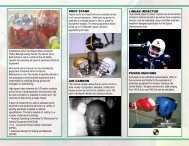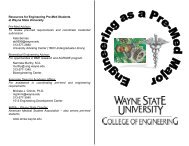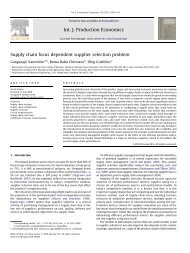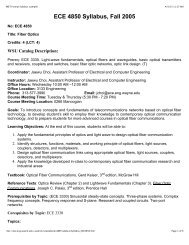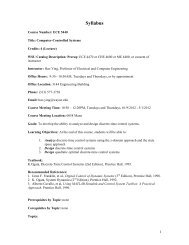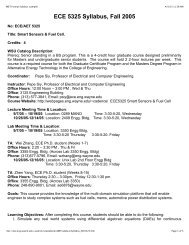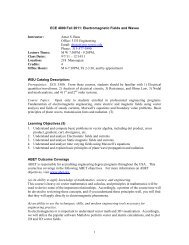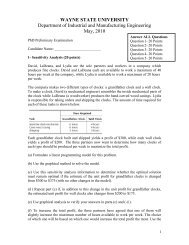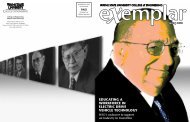ECE 4700 Syllabus - College of Engineering
ECE 4700 Syllabus - College of Engineering
ECE 4700 Syllabus - College of Engineering
You also want an ePaper? Increase the reach of your titles
YUMPU automatically turns print PDFs into web optimized ePapers that Google loves.
<strong>ECE</strong> <strong>4700</strong> <strong>Syllabus</strong>No: <strong>ECE</strong> <strong>4700</strong>Title: Introduction to Communication TheoryCredits: 4WSU Catalog Description:Prereq: BE 2100 and <strong>ECE</strong> 4330. Open only to students enrolled in pr<strong>of</strong>essional engineeringprograms. Basic information transmission concepts. Spectral analysis. Transmission throughlinear networks. Sampling principles. Digital and analog communication signals and systems. Theeffect <strong>of</strong> noise in communication systems. Elementary decision theory. (T)Coordinator: Yang Zhao, Pr<strong>of</strong>essor <strong>of</strong> Electrical and Computer <strong>Engineering</strong>Instructor: Majed Marji, Ph.D., MBAOffice Hours: After class (as needed)Phone: 586-575-0400Email: ah3055@wayne.eduClass Start/End Dates: 08/31/11 - 12/12/11Class Meeting Time: T & Th, 5:30 - 7:20 PMClass Meeting Location: 0154 MANOGoals: This course presents the core communication topics <strong>of</strong> analog modulation and digitalpulse code modulation. It also presents the fundamental tools <strong>of</strong> probability theory and randomprocesses to be used in the design and analysis <strong>of</strong> digital communication systems. The coursealso covers the fundamentals <strong>of</strong> digital communication systems. Students will be able to usethese concepts in the analysis and evaluation <strong>of</strong> modern communication systems.Learning Objectives: At the end <strong>of</strong> this course, students will be able to:1- Apply fundamental mathematical concepts to communication theory.2- Perform essential signal analyses and processing in both time and frequency domains.3- Identify the essential building blocks <strong>of</strong> communication systems and derive all governingequations.4- Write MATLAB programs to analyze signals and simulate simple modulation formats.5- Integrate basic concepts and subsystems and apply them to communication system design,analysis, and evaluation.6- Apply concepts <strong>of</strong> probability and statistics in the area <strong>of</strong> noise and signal-to-noise ratios forperformance evaluation.Textbook: Modern Digital and Analog Communication Systems, 3 thUniversity Press, 1998.ed., B.P. Lathi, OxfordReference Texts:1- Simon Haykin, Communication Systems, John Wiley & Sons, 2001 (4th Edition).2- John G. Proakis and Masoud Salehi, Communication Systems <strong>Engineering</strong>, Prentice-Hall,Inc. 2002 (2nd Edition).Prerequisites by Topic: (BE 2100) Introduction to application <strong>of</strong> probability theory and statisticalmethods in engineering, including design and manufacturing. (<strong>ECE</strong> 4330) (1) Electric circuits andKirchh<strong>of</strong>f’s laws, (2) Mechanical systems and Newton’s laws, (3) Differential equations and theirsolutions, (4) Laplace transform and its properties, (5) Impulse responses and convolutions.Corequisites by Topic: none1
Topics:1- Introduction to modern communications systems (1 week).2- Review <strong>of</strong> linear systems and signal processing techniques (3 weeks).3- Introduction to analog modulation techniques; amplitude modulation (AM) and anglemodulation (FM and PM) (4 weeks).4- Introduction to digital communications; sampling, quantization, coding ( 3 weeks).5- System evaluation in the presence <strong>of</strong> noise using probability and stochastic processes. (2weeks)Course Structure: The class meets twice a week, two hours each for a total <strong>of</strong> 4 credit hours.Computer Resources: Students need to have access to computers with MATLAB s<strong>of</strong>tware.Laboratory Resources: noneLaboratory Policy: noneDistribution <strong>of</strong> Points: Homework and Quizzes: 15%; Exam1: 25%; Exam2: 25 %; Exam3(probability review): 5%; Final Exam: 30 %.Grading Scale: A[95-100]; A-[90-94], B+[87-89]; B[83-86]; B-[80-82]; C+[77-79]; C[74-76]; C-[72-73]; D+[70-71]; D[60-69]; E[0-59]Attendance: Students are expected to attend all lectures.Schedule:• Test 1 Covers Chapters 1, 2, 3• Test 2 Covers Chapters 4, 5• Test 3 Covers Chapter 8• Final Covers Chapters 6, 9, and 10• Quizzes Will be announced• Homework Assigned and posted on BlackboardThe last day to drop any class with a tuition refund is the end <strong>of</strong> the second week <strong>of</strong> classes. Thelast day to withdraw from the class, without a notation <strong>of</strong> W on the transcript, is the end <strong>of</strong> thefourth week <strong>of</strong> classes. It is the policy <strong>of</strong> the <strong>College</strong> <strong>of</strong> <strong>Engineering</strong> not to allow withdrawals fromcourses after the end <strong>of</strong> the 5th week except under exceptional circumstances.Exams and Makeup Assignment Policy: All exams and quizzes are closed book and closednotes. No make-up quizzes or exams. No late assignments.Outcome Coverage:(a) an ability to apply knowledge <strong>of</strong> mathematics, science, and engineeringThe exercises and exams in the course require direct application <strong>of</strong> mathematical, scientific,and engineering knowledge for signal and system analyses. This requires performing varioustransformations, as well as differentiation and integration, in a formal manner and manysupporting and follow-up calculations.(c) an ability to design a system, component, or process to meet desired needs withinrealistic constraints such as economic, environmental, social, political, ethical, healthand safety, manufacturability, and sustainabilityThis outcome is a minor component <strong>of</strong> the course, but nevertheless present. A few assignedproblems require students to find desired parameters <strong>of</strong> components for achieving a set2
performance <strong>of</strong> a system, rather than directly analyze system behavior. Design concepts arediscussed and checked against real world operating limits such as signal-to-noiserequirement and power limits.(e) an ability to identify, formulate, and solve engineering problemsThe course is primarily oriented toward modern communication systems, which is a typicalengineering problem in real world. It includes examples <strong>of</strong> important engineering problems,including limited transmission power, channel noise, and detector sensitivity, which have tobe properly identified, formulated, and solved. Students will use the knowledge to identify thesystem, formulate a communication model, and solve the problem to determine requiredparameters and system performance.(i) a recognition <strong>of</strong> the need for, and an ability to engage in life-long learningStudents should understand the ever changing world <strong>of</strong> communication systems andnetworks. Examples <strong>of</strong> mobile phones, fiber optical systems, and broadband communicationsshould teach students to engage in life-long learning. Fundamental concepts and systemstaught in this course will provide students the ability to continue to learn new concepts andknowledge by themselves.(k) an ability to use the techniques, skills, and modern engineering tools necessary forengineering practice.Students will be able to use mathematical skills for signal analyses, system evaluation, andgeneral calculations. They will also use computer s<strong>of</strong>tware packages (e.g., Matlab) to designand analyze the performance <strong>of</strong> each units in the system as well as the entire system.(l) an ability to apply knowledge <strong>of</strong> probability and statistics in the analysis <strong>of</strong>communication systems.Students will be able to apply probability and statistics to analyze error and signal-to-noiseratio performance <strong>of</strong> analog communications systems and calculate the probability <strong>of</strong> bit errorfor basic digital systems. Students will also apply these tools to understand, analyze, andevaluate the behavior <strong>of</strong> communication systems.Cheating Policy and Penalty for Cheating: Cheating is defined by the University as“intentionally using or attempting to use, or intentionally providing or attempting to provide,unauthorized materials, information, or assistance in any academic exercise.” This includes anygroup efforts on assignments or exams unless specifically approved by the pr<strong>of</strong>essor for thatassignment/exam. Evidence <strong>of</strong> fabrication or plagiarism, as defined by the University in itsbrochure Academic Integrity, will also result in downgrading for the course. Students who cheaton any assignment or during any examination will be assigned a failing grade for the course.Prepared By: Majed MarjiLast Revised: Aug 28, 20113
Approximate Course Content and TimelineWeek Date Lecture Chapter Tests1T Aug 30Th Sep 1 Introduction 12T Sep 6 Introduction to Signals 2Th Sep 8 Introduction to Signals (contd.) 23T Sep 13 Introduction to Signals (contd.) 2Th Sep 15 Analysis and Transmission <strong>of</strong> Signals 34T Sep 20 Analysis and Transmission <strong>of</strong> Signals (contd.) 3Th Sep 22 Analysis and Transmission <strong>of</strong> Signals (contd.) 35T Sep 27 Analysis and Transmission <strong>of</strong> Signals (contd.) 3Th Sep 29 Analysis and Transmission <strong>of</strong> Signals (contd.) 36T Oct 4 Exam 1Th Oct 6 Amplitude Modulation 47T Oct 11 Amplitude Modulation (contd.) 4Th Oct 13 Amplitude Modulation (contd.) 48T Oct 18 Amplitude Modulation (contd.) 4Th Oct 20 Amplitude Modulation (contd.) 49T Oct 25 Angle Modulation 5Th Oct 27 Angle Modulation (contd.) 510T Nov 1 Angle Modulation (contd.) 5Th Nov 3 Angle Modulation (contd.) 511T Nov 8 Exam 2Th Nov 10 Sampling and Pulse Code Modulation 612T Nov 15 Sampling and Pulse Code Modulation (contd.) 6Th Nov 17 Sampling and Pulse Code Modulation (contd.) 613T Nov 22 Sampling and Pulse Code Modulation (contd.) 6Th Nov 24 Holiday14T Nov 29 Probability and Random Processes 8, 9Th Dec 1 Probability and Random Processes (contd.) 8, 9T Dec 6 Behavior in the presence <strong>of</strong> noise 1015 Th Dec 8 Behavior in the presence <strong>of</strong> noise (contd.) 10T Dec 13 Study Day16Th Dec 15 Final4



